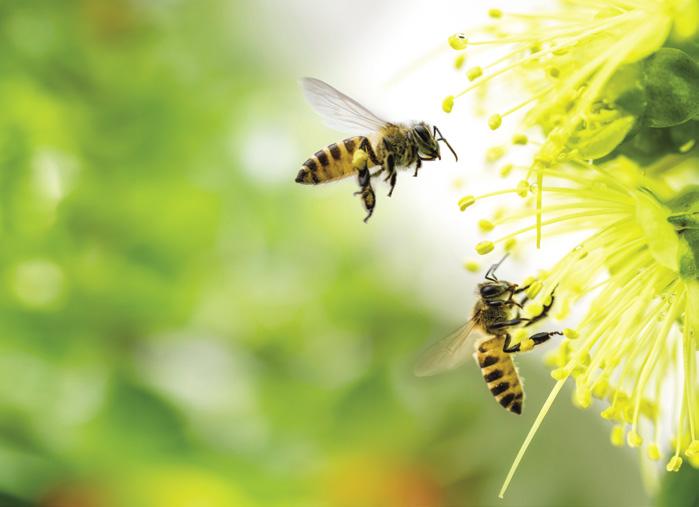
16 minute read
Bee Kind
BY REBECCA CUTHBERT
Every gardener, from the casual petunia planter to the competitive crookneck squash grower, has gotten the memo: make your gardens pollinator friendly, because if we lose our bees, we lose our flowers and our food! But how does that awareness translate to actionable steps we can all take in our own backyards?
Jeff Tome, senior nature educator, marketing director, and “bee guy” at the Audubon Community Nature Center, spends a great deal of time and energy studying these tiny heroes and how to best preserve their numbers.
Regardless of species, though, all those buzzin’ cousins share the same short list of must-haves. They need steady food sources, constant access to water, places to nest and ride out the cold months, and to not be poisoned with fertilizers and pesticides. Ring the dinner bell
As for what to plant in your garden, think variety and longevity.
Stay Young! Keep Learning! LEARNING FOR LIFE’S SEASONS with WEST SENECA COMMUNITY EDUCATION
Programs are available that provide lifestyle information, fun courses and recreational opportunities for all ages.
According to the Xerces Society for Invertebrate Conservation (xerces.org), gardeners in the Great Lakes region can do the most good by providing habitats for bees that are rich in wildflowers. Nectar is bees’ primary food source, and female bees bring pollen home to feed their little ones. Native wildflowers have the advantage of being low maintenance, as well— they require less water than nonnative blooms and don’t need to be pampered. Plants like wild lupine, dotted mint, purple coneflower, and calico aster will keep the pollen party going all summer long.
But, notes Tome, don’t forget to think big.
Broadening your definition of beauty might also be helpful. Think of it this way: every time you pull out a dandelion, a bee loses its dinner.
Less work for you and more food for them? It’s a win-win!
Provide fresh (shallow) water
This one is easy. All living things need water, but keep it shallow for bees, to reduce their chances of drowning or becoming exhausted by trying to swim. This can be as simple as filling a bowl with pebbles and water or setting out saucers in a few places throughout your garden. Make sure to check them often and refill as needed—bees won’t be the only thirsty visitors this growing season.
Give them shelter
Not all bees live in hives they build themselves. Some species live in ground nests or in hollow crevices in trees or dead logs. Some bees live in groups, while others prefer a solitary lifestyle. Also, bees may spend the winter months in different digs than they move into
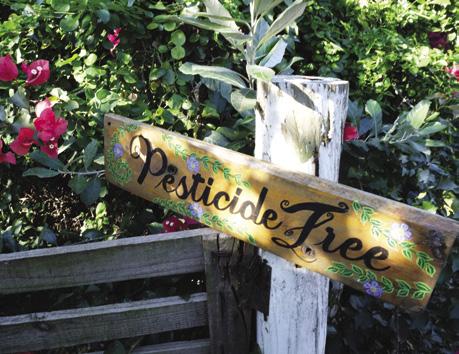
$ FIND SAVE AND
for the spring and summer, kind of like Western New York snowbirds!
To help bees find the shelter they need, don’t do too much cleanup in the fall. If there is a dead log at the edge of your yard, leave it there. If a pile of leaves gets swept against your back fence, don’t rake it up. If you need to cut a tree down, consider leaving the stump alone to decompose naturally.
In warmer months, look for bee activity around trees and yard debris and along the ground, especially before you mow. If you notice several bees hanging around in one spot, steer clear, and keep pets out of the area. The bees probably have a nest there and disturbing it could lead to stings.
Ditch the poisons
Harmful garden chemicals like fertilizers, fungicides, herbicides, and pesticides are killing bees at alarming rates. Bees are exposed to these toxins directly, through sprays; and indirectly, by eating poisoned nectar and nesting on or with contaminated material. The less clean, green space bees can access, the more their numbers will shrink.
Instead, expand your garden horizons with new knowledge and adjusted thinking. Skip synthetic fertilizers and research natural compost. Plant native species that you won’t need to fuss over. Learn to love the cheerfulness of dandelions. Look up organic pest deterrents and plant insect- and disease-resistant varieties of flowers and vegetables. After all, isn’t the joy of discovery why you fell in love with gardening in the first place?
Creating a bee-friendly garden isn’t as hard as you may have thought. By letting the dandelions grow and leaving the brush pile to rot, it means less work for you! To increase your positive impact, encourage your neighbors to adopt the same practices, so bees feel welcome up and down your street. As a reward, you’ll all have healthier gardens, enjoy more flowers and vegetables, and hear the best song of the summer—the contented drone of bees buzzing around your backyard! FY
Rebecca Cuthbert lives, writes, and cares for shelter dogs in Dunkirk. She is a frequent contributor to Forever Young.
Buy One Admission & Get One
FREE of equal or lesser value
Good through 10/31/20 Please see website for days & times Good for regular park admission only. Not good for any special events including Arts at the Gardens and cannot be combined with another discount or coupon.
151 Charlotte Street | Canandaigua, New York | 585-394-4922 | sonnenberg.org
McGuire Group Facilities Rank Top in the State, Nation
The federal Centers for Medicare and Medicaid, CMS, recently ranked the McGuire Group’s five WNY facilities in the top 2 percent in the nation for quality metrics. In addition, the group’s Autumn View Health Care Facility in Hamburg was rated No. 1 in the state and No. 2 in the nation out of more than 15,000 nursing homes.
The McGuire Group’s other WNY facilities include: Garden Gate Health Care Facility in Cheektowaga, Harris Hill Nursing Facility in Williamsville, Northgate Health Care Facility in North Tonawanda and Seneca Health Care Center in Wet Seneca.
The metrics take into account consistency in monitoring and managing best practices, quality assurance, performance improvement, hospital readmissions and more. “Care at the bedside translates into success with outcomes,” stated Aaron Polanski, Autumn View’s administrator. “It’s important to be consistent while focusing on best practices, system development and team communication; together, that results in high quality patient care.”
To efficiently monitor metrics, the company utilizes StarPro data analytics software to assist in identifying potential triggers. Clinicians then utilize this information to create care plans, targeted rehabilitative programs and strategic goals to proactively treat those who indicate a potential for decline.
The McGuire Group’s facilities are also rated five stars out of five by CMS based on data that includes health inspections, staffing and quality measures.
The McGuire Group facilities provide subacute and outpatient rehabilitation, skilled nursing care, memory care, palliative care and respite/short-term care. For more information visit www. mcguiregroup.com, www.medicare. gov or www.getstarpro.com.
Loving Your Political Opposite
BY JUDITH A. RUCKI
Anyone who has survived a few Buffalo winters knows what it means to hunker down during a storm. As long as the household is safe and has provisions, it can be fun to have a little down time. Curl up by the fireplace, read a good book, make some cocoa, and, before you know it, you’re back out in the world.
But, these days, it’s a whole different world. As of this writing, we don’t know when things will return to normal, or some semblance thereof. Needing a trip to the hair salon is one thing, but suffering financial hardship can make things tense, to say the least.
Wherever we are in the mix, living in proximity day in and day out to one or more loved ones can be trying. After a while, everything from the way she chews to the way he cracks his knuckles can be cause for a row.
Add politics to the mix, and fireworks can happen, especially if our nearest and dearest is on the opposite side of the political spectrum.
Anyone who looks at social media (and many of us are doing too much of that these days) can see that things are getting ugly. There are wildly varying opinions on who to believe and trust and everything in-between.
So, what coping mechanisms can we use to keep our marriages and relationships intact?
For starters, we might remind ourselves that no matter how passionate we are about politics, it’s likely we are more passionate about our loved ones. Adopt the mantra, “It’s just politics.” No matter how much you might disagree, political views are no reason to ruin a loving relationship.
If you have been married or in a relationship for a good amount of time, chances are you have similar values regarding family and what you want from life. The appropriate role of government in our lives may mean something different to each of us and be cause for arguments. But, how important is being “right” when it can cost you a relationship?
Discussing issues with cool heads can lead to a better understanding of the other side. Skip the yelling and hurling of insults. If we really listen to each other, we might see where the other is coming from and gain a better understanding of each other.
It’s OK to define and defend your beliefs, but remember to be patient and kind while doing so. Relationships run much more smoothly when each party respects the other’s differences.
Sometimes we need to agree to disagree. This works best when both partners feel like they’ve been heard. Couples need to know how each other thinks and make an effort to acknowledge the other’s point of view.
If that isn’t working, there is always marriage counseling. Or else we can turn off the TV and stay away from social media.
Still looking for ways to talk things out without going for your beloved’s jugular?
The book Couple Talk: How to Talk Your Way to a Great Relationship shows us how to become “response-able” communicators with the ability to respond appropriately and effectively while encountering everyday situations. Authors Thomas Haller and Chick Moorman advise couples to encourage each other to keep talking. And no tuning each other out. We each need to demonstrate a willingness to listen and discuss the issue, rather than cutting each other off.
No matter how hard couples try to stay cool, arguments can happen. Haller and Moorman suggest talking about how you and your partner argued. Figure out what was good or productive about the way you treated each other during the argument. Disagreeing does not necessarily doom a relationship. Figure out why you think differently from each other.
Consider ignoring a party affiliation and focus on specific issues. You may find you agree on more than you realized. At the same time, it is unrealistic to expect two people to agree on everything.
When you do sit down to talk—not argue—keep a few things in mind:
Stay calm and make eye contact. No raging around the room.
Yelling does not get your point across.
Ask questions. If you really listen to each other, and care what the other has to say, you should feel more connected to each other.
Now for an anecdote. A couple I knew had completely different political beliefs. He constantly offered his opinions. She rarely said anything. When asked how they managed to not argue, she said she just let him talk. Then she would vote for whomever she wanted and never reveal her choice.
Sometimes playing it close to the vest is the best option of all. FY


thank you ♥
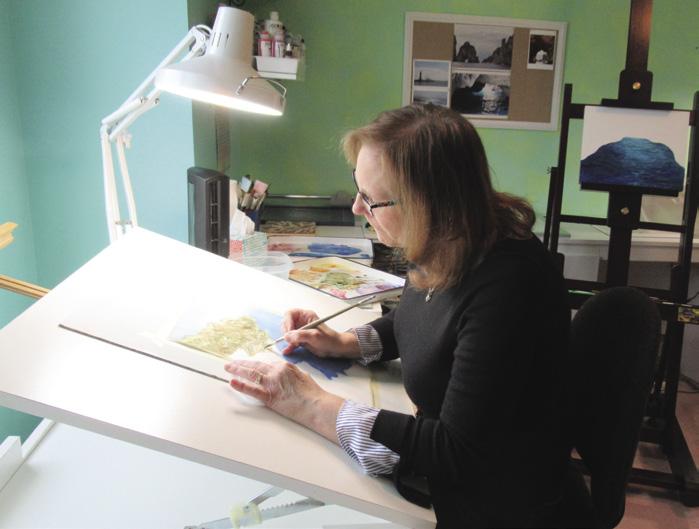
Artist Deanna Weinholtz
BY CHRISTINE A. SMYCZYNSKI
Local watermedia artist Deanna Weinholtz at work in her studio Photo by Christine A. Smyczynski
When you’re an artist, it’s not just a job, it’s your identity. Watermedia artist Deanna Weinholtz was always drawing as a young girl. She credits one of her aunts, who is also an artist, as her inspiration. “I looked up to her and we always talked about art when she came to visit,” Weinholtz says.
Her work is informed by weekends and summers spent at Redwing Cottages, the summer resort built by her great-grandfather on Lake Chemong, located two hours north of Toronto, Ontario.
“A lot of my inspiration comes from being outside; there was no television at the cottage until I was in high school, so we had to find our own entertainment,” says Weinholtz. As a child and teen, she spent her time at the cottage watching the Northern Lights, lying on the beach at night looking at the stars, and sitting by the lake listening to the water lap against the rocks lining the shore.
“A lot of my water-themed paintings are inspired by this,” says Weinholtz. “When we go out there
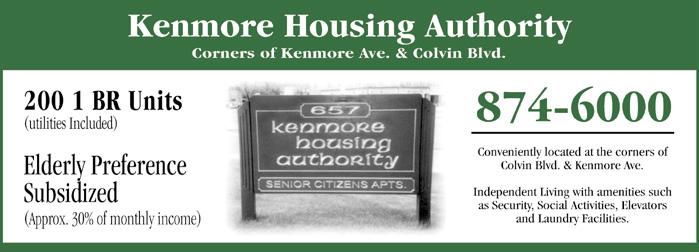
now, once we get past Toronto and get into the countryside, I feel peaceful and that I am home.”
Weinholtz graduated from Buffalo State College with a degree in graphic design and worked in that field for several years before her husband John and she started a family. “I was always doing something artistic, even when raising the kids; making floral arrangements, dressmaking, and more.” Now that her three kids are grown, it’s come full circle, she says. “Drawing and painting are my artistic outlets; it’s not just a job, it’s who I am.”
Painting techniques
Weinholtz’s art, which features seascapes and landscapes, can best be described as Representational Abstract; realistic, but not; it’s bit looser than realism. She uses optical mixing of her paints, mixing her colors in thin layers on the painting, rather than on a pallet. When working with acrylic paints, she uses them almost like watercolors, adding layer upon layer to create depth and dimension, sometimes using her fingers and rags as tools to achieve the effect.
When she paints during the day, she plays loud music and dances and sings. “I feel joy while I paint!” In the evening, she puts on more mellow classical or Italian music and draws. “Drawing is my happy place,” says Weinholtz. Her inhome art studio was designed and built by Weinholtz and her father.
Buyers identify with the themes in her paintings, for example, sunsets over water. “Many people go to the same place for vacation every year; some will say, ‘That painting reminds me of__’”.
Art as therapy
Two years ago, when she and her husband took a trip to Italy to celebrate their thirtieth anniversary, Weinholtz was injured while touring Pompeii. She fell three feet off an elevated area, fracturing her spine and breaking both her wrists, an injury that would be bad for anyone, but devastating for an artist.
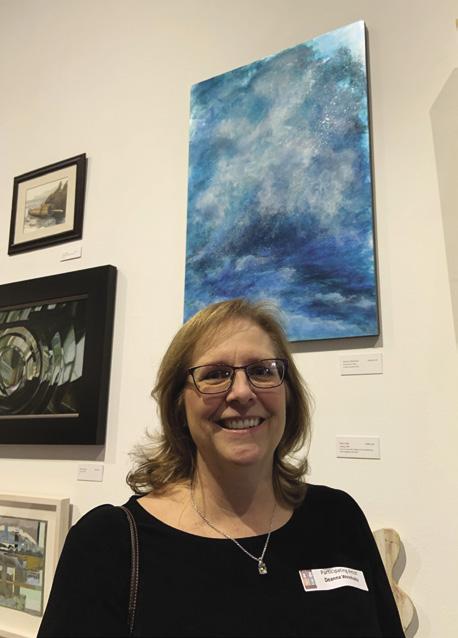
Teaching art
“I never saw myself as a teacher,” says Weinholtz. But, when she was invited to give a demonstration to the Niagara Frontier Watercolor Society, she agreed to do it. “I was terrified to speak in front of people and was nervous at first about painting in front of my peers for two hours. However, once I got started, I relaxed and thoroughly enjoyed it.” During intermission, people came up to her and asked if she taught classes. “I heard myself saying, ‘Why, yes, yes I do!’”
Weinholtz normally teaches classes at the River Art Gallery and Gift Shop (www.riverartgalleryandgifts. com) in North Tonawanda, where she is a resident artist, as well as at Hyatt’s on Elmwood Avenue in Buffalo. (www.hyatts.com). This spring, due to the pandemic, she was unable to continue in-person classes for current students, so she experimented with teaching online classes on Zoom. Her work was included as part of 20/20 Vision: Women Artists in Western New York at the Castellani Art Museum, (www. castellaniartmuseum.org) on the campus of Niagara University and she was selected to be an exhibitor in the 100 American Craftsmen 50 th Golden Anniversary Show at the Kenan Center, Lockport, which was canceled due to the coronavirus pandemic, but has artist work available online at www.100americancraftsmen.com. Weinholtz also submits her artwork to local, regional, and national art shows and has won several local and national awards.
To find out more about Deanna Weinholtz and to see examples of her artwork, visit her website www. deannaweinholtz.com.
FY
Weinholtz spent almost a year recovering while working with an occupational therapist and then a personal trainer. While she was first recuperating from wrist surgery and had casts on, she spent her time playing DVDs of her favorite artists at work and studied color theory and design. Once the casts came off, she had to wear splints, which she took off only for therapy and drawing. However, her wrists were still fractured, and drawing was painful. Her therapist encouraged her to paint, rather than draw, but Weinholtz insisted on drawing because it calmed and centered her.
As she healed, her therapist continued to encourage her to paint with large brush strokes to help regain movement in her wrists and fingers. She finally decided to try painting with watercolors. Her first painting was In Un Prossimo Futuro this means “in the near future” in Italian. It was based on the last photo she took in Italy before she fell. This painting won “People’s Choice Award” in the Buffalo Society of Artists Member’s Exhibition.
Weinholtz with her work Purple Mist at NU's Castellani
Photo courtesy Deanna Weinoltz
Christine Smyczynski is the author of Explorers Guide Buffalo Niagara Falls and Backroads & Byways of Upstate New York.
The BEST Care is Delivered by M c GUIRE MISSION MAKERS!
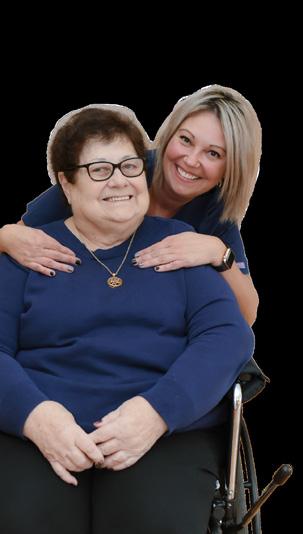
“The best part of my job is knowing that I make a difference in the residents’ lives; they know they can depend on me.” - Amy Lovelace
5-STAR REHAB & NURSING CARE
Amy Lovelace & resident Shirley Schweikert
Autumn View • Hamburg Garden Gate • Cheektowaga
Harris Hill • Williamsville Northgate • N. Tonawanda
Seneca • West Seneca



